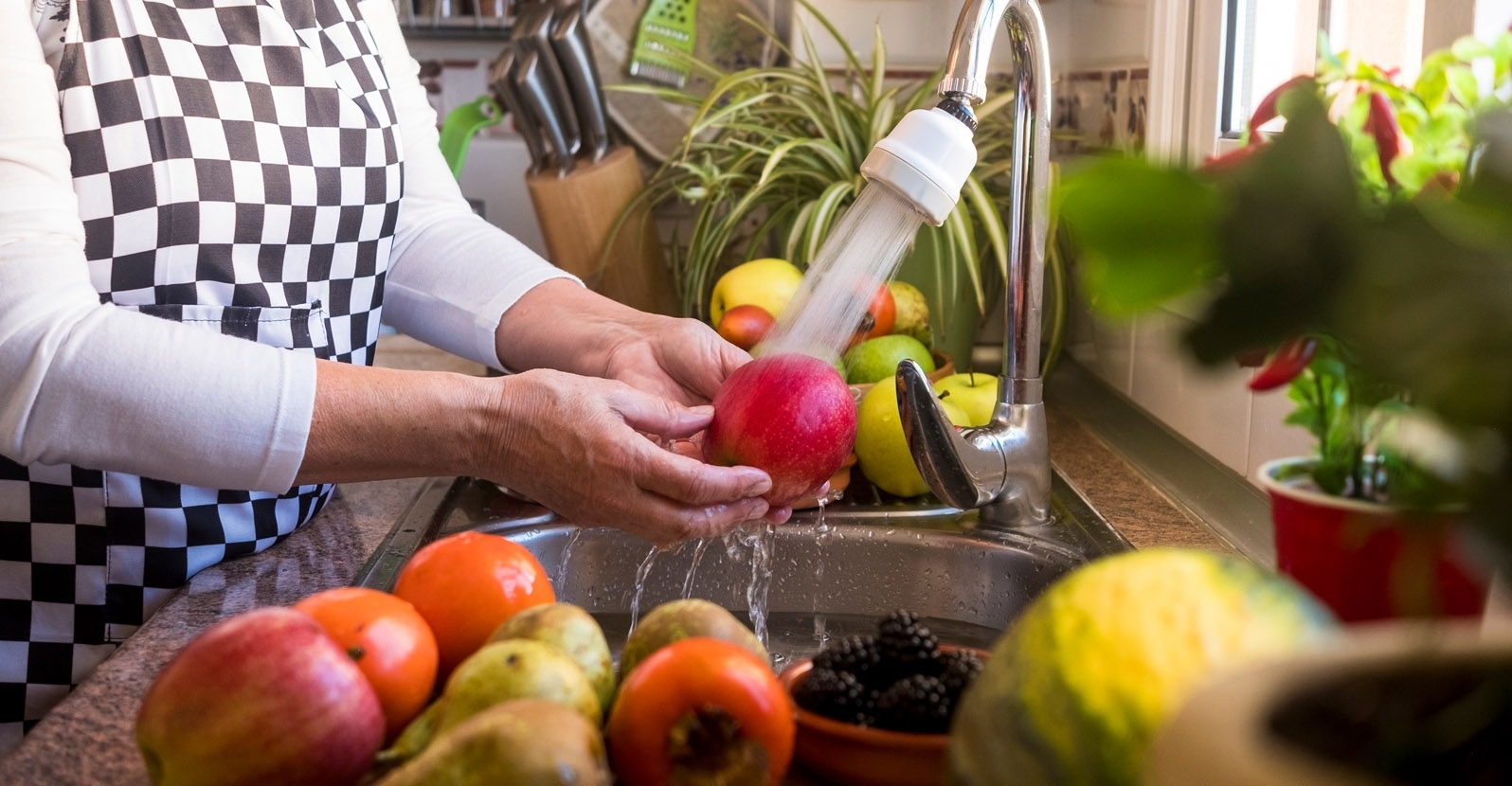Home>Types of Gardening>Edible Gardening>What Are Raw Fruits And Vegetables


Edible Gardening
What Are Raw Fruits And Vegetables
Modified: January 22, 2024
Discover the benefits of edible gardening with raw fruits and vegetables. Improve your health and enjoy the freshness of homegrown produce.
(Many of the links in this article redirect to a specific reviewed product. Your purchase of these products through affiliate links helps to generate commission for Chicagolandgardening.com, at no extra cost. Learn more)
Table of Contents
- Introduction
- Definition of Raw Fruits and Vegetables
- Benefits of Consuming Raw Fruits and Vegetables
- Nutritional Value of Raw Fruits and Vegetables
- Different Types and Varieties of Raw Fruits and Vegetables
- Tips for Including More Raw Fruits and Vegetables in Your Diet
- Potential Risks and Precautions with Raw Fruits and Vegetables
- Conclusion
Introduction
Welcome to the world of raw fruits and vegetables! The concept of consuming these fresh and unprocessed treasures from nature has gained immense popularity in recent years. Raw fruits and vegetables are packed with essential nutrients, vitamins, and minerals that are beneficial for our overall health and wellbeing. Whether you’re a seasoned gardener with a flourishing edible garden or someone who simply enjoys the natural goodness of raw produce, this article will delve into the fascinating world of raw fruits and vegetables.
Raw fruits and vegetables are uncooked and unprocessed forms of plant-based foods that are consumed in their natural state. Unlike cooked or processed foods, raw produce retains its natural flavors, textures, and most importantly, its nutritional value. This means that when you enjoy a raw fruit or vegetable, you’re getting a powerhouse of nutrients that can support your health in numerous ways.
The popularity of raw fruits and vegetables stems from the growing awareness of their numerous health benefits. These uncooked gems are rich in dietary fiber, antioxidants, and essential vitamins and minerals. Plus, they provide hydration, boost energy levels, and support digestion. Incorporating raw fruits and vegetables into your daily diet can promote weight management, strengthen your immune system, improve skin health, and reduce the risk of chronic diseases.
Raw fruits and vegetables are incredibly diverse, with a wide range of colors, flavors, and textures. From the vibrant reds of ripe tomatoes and peppers to the crisp green leaves of lettuce and spinach, there’s a raw produce option to suit every palate. You can enjoy juicy fruits like apples, oranges, and berries, or crunchy vegetables like carrots, cucumbers, and celery. With such a variety to choose from, raw fruits and vegetables can add excitement and flavor to any meal or snack.
Whether you’re an experienced gardener with an abundant supply of fresh produce or someone who frequents farmers’ markets and grocery stores, including more raw fruits and vegetables in your diet is easier than you may think. In the following sections, you’ll discover different types and varieties of raw produce, along with tips and ideas to incorporate them into your meals. But before we dive into the details, let’s take a closer look at the remarkable nutritional value of raw fruits and vegetables.
Definition of Raw Fruits and Vegetables
Raw fruits and vegetables are the uncooked, unprocessed forms of plant-based foods that are consumed in their natural state. They are harvested directly from the plant and are typically eaten without undergoing any cooking or processing methods such as boiling, steaming, or frying.
Raw fruits refer to the edible reproductive parts of flowering plants, such as apples, oranges, berries, and melons. These fruits are often characterized by their vibrant colors, juiciness, and sweetness. They are rich in vitamins, minerals, dietary fiber, and natural sugars, which provide instant energy and contribute to overall health and wellbeing.
On the other hand, raw vegetables are the edible parts of plants other than the fruits. These can include leaves, stems, roots, or even flower buds. Leafy greens like spinach, lettuce, and kale fall into this category, as well as root vegetables like carrots, potatoes, and beets. Raw vegetables offer a wide variety of flavors, textures, and nutrients, making them versatile additions to any diet.
The defining feature of raw fruits and vegetables is their uncooked nature. This means that they retain their natural flavors, textures, and nutritional composition. Cooking methods, such as boiling or frying, can alter the taste, texture, and nutritional content of these foods. While cooking processes may enhance the flavors or make certain nutrients more bioavailable, consuming raw fruits and vegetables ensures that you receive the maximum amount of nutrients that nature intended.
It’s important to note that not all fruits and vegetables are typically consumed raw. Some varieties are commonly cooked or processed before consumption due to their texture or taste. For example, raw potatoes are often not consumed due to their starchiness and raw eggplants may have a bitter taste. However, the majority of fruits and vegetables can be enjoyed in their raw state, providing a wide range of options to suit different tastes and preferences.
Now that we have a clear understanding of what raw fruits and vegetables are, let’s explore the numerous benefits that come with consuming these nutritious powerhouses!
Benefits of Consuming Raw Fruits and Vegetables
Consuming raw fruits and vegetables offers a multitude of benefits for our overall health and wellbeing. These nutrient-dense foods are packed with vitamins, minerals, antioxidants, and fiber, all of which play vital roles in promoting a healthy body. Let’s explore some of the key benefits of including raw fruits and vegetables in our diets:
- Nutrient-rich: Raw fruits and vegetables are rich in essential vitamins and minerals that are necessary for the proper functioning of our bodies. These include vitamins A, C, and K, as well as folate, potassium, and magnesium, among others. By consuming them in their raw form, we can ensure that we are receiving the maximum amount of these nutrients.
- Hydration: Many raw fruits and vegetables have high water content, which can help keep the body well-hydrated. Foods such as cucumbers, watermelon, and strawberries are excellent choices to increase hydration levels and maintain proper bodily functions.
- Fiber-rich: Raw fruits and vegetables are excellent sources of dietary fiber, which is crucial for a healthy digestive system. Fiber aids in regular bowel movements, prevents constipation, and promotes a feeling of fullness, which can be beneficial for weight management.
- Antioxidant power: Raw fruits and vegetables are packed with antioxidants, which help protect our cells from damage caused by harmful free radicals. Antioxidants play a vital role in reducing the risk of chronic diseases, including heart disease, certain types of cancer, and age-related macular degeneration.
- Boosts immune system: Many raw fruits and vegetables contain immune-boosting nutrients, such as vitamin C and zinc, which help strengthen the immune system. Regular consumption of these foods can help fight off infections and reduce the risk of illnesses.
- Improved digestion: The fiber found in raw fruits and vegetables promotes healthy digestion by aiding in the movement of food through the digestive tract. Additionally, raw produce contains enzymes that can assist in breaking down food and improving nutrient absorption.
- Weight management: Raw fruits and vegetables are low in calories and high in fiber, making them excellent choices for those aiming to maintain or lose weight. The high fiber content can help control appetite and provide a feeling of fullness, leading to reduced calorie intake.
- Enhanced skin health: The vitamins and antioxidants present in raw fruits and vegetables contribute to healthy skin. They help protect the skin against damage caused by environmental factors, promote collagen production, and provide essential nutrients for a radiant complexion.
Incorporating raw fruits and vegetables into our daily diet can have a significant impact on our overall health and wellbeing. Whether consumed as a refreshing snack, in salads, smoothies, or as a side dish, the benefits of these nutrient-rich foods are undeniable. Let’s now explore the remarkable nutritional value of raw fruits and vegetables.
Nutritional Value of Raw Fruits and Vegetables
Raw fruits and vegetables are nutritional powerhouses that provide a wide array of essential vitamins, minerals, fiber, and antioxidants. Let’s take a closer look at the remarkable nutritional value of these unprocessed plant-based foods:
Vitamins: Raw fruits and vegetables are abundant sources of various vitamins that are vital for our overall health. For example, citrus fruits like oranges and lemons are packed with vitamin C, which is essential for a healthy immune system and collagen production. Leafy green vegetables such as spinach and kale are excellent sources of vitamin K, important for bone health and blood clotting. Additionally, different fruits and vegetables provide a range of B vitamins, like folate, thiamine, and vitamin B6, which promote energy production and neurological function.
Minerals: Raw fruits and vegetables are also rich in essential minerals that our bodies require for proper functioning. Potassium, found in bananas, avocados, and sweet potatoes, plays a crucial role in maintaining fluid balance and healthy blood pressure. Magnesium, abundant in leafy greens and legumes, contributes to muscle and nerve function, as well as bone health. Calcium, commonly associated with dairy products, can also be obtained from raw produce such as broccoli, kale, and collard greens.
Fiber: Raw fruits and vegetables are excellent sources of dietary fiber, which is important for maintaining a healthy digestive system. Fiber adds bulk to the diet, aiding in regular bowel movements and promoting satiety. It also helps regulate blood sugar levels and can contribute to a reduced risk of heart disease and certain types of cancer. Apples, pears, and raspberries are particularly high in dietary fiber, while vegetables like broccoli, Brussels sprouts, and carrots also provide a good amount.
Antioxidants: Raw fruits and vegetables are packed with antioxidants, which help protect our cells from damage caused by free radicals. These harmful compounds can contribute to aging and various chronic diseases. The antioxidant content in raw produce varies depending on the type and color. For instance, berries like blueberries and strawberries are rich in anthocyanins, while tomatoes contain the antioxidant lycopene. Leafy green vegetables like spinach and kale provide antioxidants such as vitamins C and E, as well as beta-carotene.
Phytochemicals: Raw fruits and vegetables contain numerous compounds known as phytochemicals, which play a key role in promoting good health. These include carotenoids, flavonoids, and glucosinolates, among others. Phytochemicals have antioxidant and anti-inflammatory properties and have been linked to a reduced risk of chronic diseases, including heart disease and certain types of cancer.
By incorporating a variety of raw fruits and vegetables into our diet, we can enjoy a wide range of nutrients that contribute to our overall health and wellbeing. From vitamins and minerals to fiber and antioxidants, these unprocessed plant-based foods provide a natural and wholesome way to nourish our bodies. Now, let’s explore the different types and varieties of raw fruits and vegetables available to us.
Different Types and Varieties of Raw Fruits and Vegetables
The world of raw fruits and vegetables is incredibly diverse, offering a wide range of types and varieties to suit every taste and preference. Here are some popular options to consider:
- Leafy greens: Leafy greens like spinach, kale, lettuce, and Swiss chard are packed with vitamins A, C, and K, as well as folate and fiber. They can be enjoyed in salads, added to smoothies, or used as wraps for a nutritious and refreshing meal.
- Citrus fruits: Citrus fruits such as oranges, grapefruits, lemons, and limes are bursting with vitamin C. They offer a refreshing and tangy flavor, perfect for enjoying on their own, squeezed into a glass of water, or added to salads and sauces.
- Berries: From strawberries, blueberries, and raspberries to blackberries and cranberries, berries are rich in antioxidants and dietary fiber. They can be enjoyed fresh, added to yogurt or smoothies, or used in baking for a burst of natural sweetness.
- Cruciferous vegetables: Vegetables like broccoli, cauliflower, Brussels sprouts, and cabbage belong to the cruciferous family. They are packed with nutrients, including fiber, vitamins C and K, and cancer-fighting compounds. These versatile vegetables can be enjoyed raw in salads, as crunchy snacks, or lightly steamed for a tender texture.
- Root vegetables: Root vegetables like carrots, beets, radishes, and sweet potatoes are not only delicious but also rich in vitamins and minerals. They can be enjoyed raw in salads, grated for slaws, or roasted to enhance their natural flavors.
- Tropical fruits: Pineapple, mango, papaya, and kiwi are just a few examples of delicious tropical fruits that are full of flavor and tropical goodness. They are a fantastic source of vitamins, minerals, and enzymes. Enjoy them on their own, in salsas, or as refreshing additions to smoothies and cocktails.
- Tomatoes and peppers: Tomatoes and peppers, whether they are juicy red tomatoes, sweet cherry tomatoes, or vibrant bell peppers, offer a burst of flavor and are excellent sources of vitamins A and C. They can be enjoyed raw in salads, used as toppings for sandwiches and pizzas, or grilled for added smokiness.
- Melon family: Watermelon, cantaloupe, honeydew, and other melons are perfect choices for hydrating and refreshing snacks. These juicy fruits are rich in vitamins A and C and can be enjoyed on their own or added to fruit salads and smoothies for a burst of summer flavor.
This is just a glimpse of the vast array of raw fruits and vegetables available for consumption. When selecting produce, try to opt for a variety of colors to ensure a diverse range of nutrients. Incorporating different types and varieties of raw fruits and vegetables into your diet can add excitement and flavor to your meals while providing a vast array of health benefits.
Tips for Including More Raw Fruits and Vegetables in Your Diet
Incorporating raw fruits and vegetables into your daily diet is a fantastic way to boost your nutrient intake and enjoy vibrant flavors and textures. Here are some practical tips to help you include more raw produce in your meals and snacks:
- Start small: Begin by adding a serving of raw fruits or vegetables to one meal each day. For example, you can have a side salad with lunch or add sliced fruits to your breakfast yogurt. As you become comfortable, gradually increase your raw produce intake.
- Keep them accessible: Wash, chop, and store your raw fruits and vegetables in clear containers in the refrigerator. Having them readily available and visible will make it easier to grab them for a quick snack or add them to meals.
- Get creative with salads: Salads are a wonderful way to incorporate raw produce. Experiment with different combinations of greens, fruits, vegetables, and toppings. Add nuts, seeds, or a sprinkle of cheese for extra flavor and texture.
- Make smoothies: Smoothies are an excellent way to consume a variety of raw fruits and vegetables at once. Blend your favorite combination of fruits, leafy greens, and a liquid base like water, coconut water, or almond milk. You can also add some nuts or seeds for added protein and healthy fats.
- Try vegetable wraps or lettuce cups: Replace traditional bread or tortillas with large lettuce leaves or collard green wraps. Fill them with a variety of fresh vegetables, avocado, and lean protein for a crunchy and nutritious meal.
- Snack on raw produce: Keep a bowl of fresh fruits like apples, grapes, or berries on your countertop for easy snacking. Cut up raw vegetables like cucumbers, bell peppers, and carrots, and pair them with a healthy dip like hummus or Greek yogurt for a satisfying snack.
- Experiment with raw sauces and dressings: Instead of using store-bought dressings, try making your own raw sauces and dressings using ingredients like avocado, herbs, lemon juice, or olive oil. These can add flavor and enhance the appeal of raw fruits and vegetables.
- Explore international cuisines: Different cultures have their own unique ways of preparing and enjoying raw fruits and vegetables. Look for recipes from around the world, such as Thai papaya salad, Greek salad, or Mexican salsa, to discover new flavors and combinations.
- Visit farmers’ markets: Explore your local farmers’ markets to find a wide variety of fresh and seasonal raw produce. Connecting with local farmers can provide you with unique and flavorful options that you may not find in regular grocery stores.
- Grow your own: Consider starting your own edible garden to cultivate fresh fruits and vegetables. It’s a rewarding experience and ensures that you have a constant supply of high-quality raw produce right at your fingertips.
Remember, the key is to enjoy the process of incorporating raw fruits and vegetables into your daily routine. Experiment with different flavors, textures, and combinations to find what suits your taste buds. By incorporating more raw produce into your diet, you’ll not only experience the health benefits but also indulge in delicious and vibrant dishes.
Potential Risks and Precautions with Raw Fruits and Vegetables
While raw fruits and vegetables offer numerous health benefits, it’s important to be aware of potential risks and take necessary precautions to ensure safe consumption. Here are some considerations to keep in mind:
- Foodborne illnesses: Raw produce, especially when not properly washed or contaminated with bacteria, can pose a risk of foodborne illnesses. Thoroughly rinse raw fruits and vegetables under running water before consumption to minimize the risk of contamination.
- Pesticide residue: Conventionally grown fruits and vegetables may contain pesticide residue. To reduce exposure, choose organic options or wash non-organic produce with a vegetable wash or a mixture of water and vinegar.
- Allergies: Some individuals may have allergies to specific raw fruits and vegetables. Common allergens include berries, citrus fruits, and certain types of nuts. If you have any known allergies or sensitivities, consult with a healthcare professional before introducing new raw produce into your diet.
- Gastrointestinal discomfort: Raw fruits and vegetables, particularly those high in fiber, can cause gastrointestinal discomfort, such as bloating or gas, in some individuals. Gradually increase your intake to allow your digestive system to adjust.
- Oxalate content: Certain raw vegetables, such as spinach and beet greens, contain high amounts of oxalates, which can contribute to the formation of kidney stones in susceptible individuals. If you have a history of kidney stones, speak with your healthcare provider about appropriate consumption levels.
- Individual sensitivities: Some individuals may experience sensitivities or digestive issues when consuming certain raw fruits or vegetables. Pay attention to your body’s reactions and modify your intake accordingly.
- Interactions with medication: If you are taking medications, be aware that certain fruits and vegetables can interact with them. Grapefruit, for example, can interact with certain medications, including some cholesterol-lowering drugs. Consult your healthcare provider or pharmacist if you have any concerns.
It’s essential to listen to your body and make informed decisions about the types and quantities of raw fruits and vegetables you consume. If you have any specific health conditions or concerns, it’s always a good idea to consult with a healthcare professional before making significant changes to your diet.
By following proper food safety practices, choosing organic options when possible, and being aware of individual sensitivities and potential risks, you can enjoy the many benefits of raw fruits and vegetables while minimizing any potential drawbacks.
Conclusion
Incorporating raw fruits and vegetables into your diet can have a profound impact on your overall health and wellbeing. These unprocessed gems are packed with essential nutrients, vitamins, minerals, fiber, and antioxidants that support various bodily functions and reduce the risk of chronic diseases. From leafy greens and vibrant fruits to root vegetables and tropical treats, the world of raw produce offers an incredible variety of flavors, colors, and textures to explore.
By introducing more raw fruits and vegetables into your meals and snacks, you can experience the benefits of increased hydration, improved digestion, enhanced immune function, and weight management. Additionally, the wealth of vitamins, minerals, and phytochemicals found in raw produce can contribute to healthy skin, cardiovascular health, and overall vitality.
It’s important to take necessary precautions, such as proper washing and organic choices, to minimize potential risks associated with raw produce. Being aware of individual sensitivities, allergies, or interactions with medication is also crucial for safe consumption.
So, whether you’re a seasoned gardener with a bountiful edible garden or someone who loves exploring farmers’ markets and grocery store aisles, raw fruits and vegetables can play a starring role in your culinary adventures. Embrace the diversity of flavors, get creative with your meal preparations, and savor the natural goodness of raw produce.
Remember, the journey towards a healthier lifestyle is about finding balance and incorporating a variety of nutritious foods into your diet. With an abundance of raw fruits and vegetables available, you have endless possibilities to nourish your body and indulge in delicious, wholesome meals. So, embrace the raw goodness and let nature’s bounty nourish and delight you!










